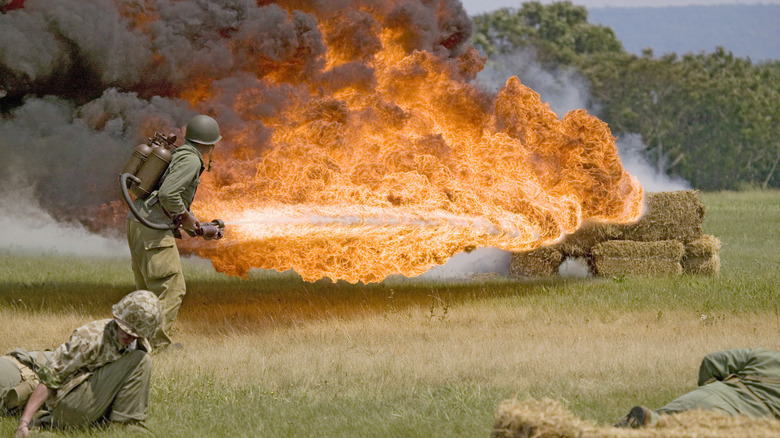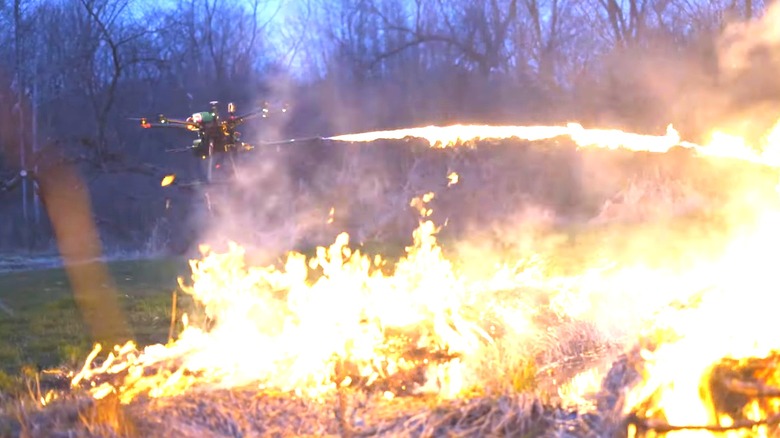Do Any Modern Militaries Still Use Flamethrowers?
In 2020, official images released from the China Military Network as reported by Popular Mechanics, that show the People's Liberation Army (PLA) using flamethrowers, which may be one of the last modern forces in the world still doing so. While these fiery implements do appear to still serve a similar specialized combat role among certain companies, like they have in the past, Chinese soldiers are also using the flamethrower as a means to eliminate dangerous pests.
Harnessing the power of fire as a weapon dates back to ancient Greece, with a device called "Greek Fire." While flame weapons reportedly had their place on the early battlefield, it wasn't until the first World War that nations got a glimpse of the next step in fire-based weaponry: the technologically-enhanced flamethrower. Its destructive capability, inflicted not only physical damage upon an enemy force, but also a powerful psychologic effect, striking fear in those standing against it. The flamethrower wasn't the only advancement to come out of this time period, as it also became the birthplace of the tank, with necessity sparking innovation in WW1.
Fast forward into the 21st century, and while flamethrowers have largely been phased out of militaries across the world, they have recently found a new purpose and new enemy, in the form of the Asian giant hornet. And Chinese forces have decided to incorporate a phrase into their operations commonly used in response to venom infused vermin, "kill it with fire!"
China's flamethrowers are serving in a multipurpose role
The Asian giant hornet, also known as the "murder hornet," can not only grow to be an inch and ½ in length, but features a massive sized bite, making it capable of taking off the head of honey bees. Back in 2019, these large insects made headlines when they were spotted in the US, and concerns for the honey bee population began to mount.
Evidently, China is taking measures to lower the population of the Asian giant hornet using fire to safely destroy certain nests from a distance. While threats to humans from these creatures is typically low, their sting is said to be quite painful, and an angry swarm could become life threatening with repeated attacks delivering large amounts of venom.
Fortunately, US officials reported late last year that these giant hornets have been effectively removed from America's soil, with no new populations discovered in three years. If they ever come back, drones could be the key to eradicating murder hornets.
The future of flamethrowing technology
While the classic hand-held flamethrower proved a useful tool in both World Wars and other conflicts like the Korean and Vietnam war, it had some glaring disadvantages. For one thing, soldiers were required to carry cumbersome fuel tanks on their backs, making them a slow-moving obvious target for enemy fire. In addition, range was highly limited, so when shoulder fired rocket launchers were able to strike opposing forces from much further away, the classic flamethrower became obsolete.
However, there are some new versions of this technology that retain the flamethrowers strengths, while removing some of the disadvantages of previous iterations. For instance, the TF-19 Drone Flamethrower attachment, allows you to utilize a remotely piloted drone equipped with the ability to shoot flames up to 25 feet, for around a minute and half straight. This is a commercially available tool and can be used for a variety of tasks such as controlled burns, and pest management.
Although, Ukrainian military forces were spotted in 2024, using a drone with a flamethrower to ignite an area of dense vegetation to reveal enemy positions as reported by Forbes. In terms of America's armed forces, meet the new military drones being integrated into US Army companies and battalions.


